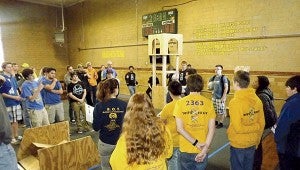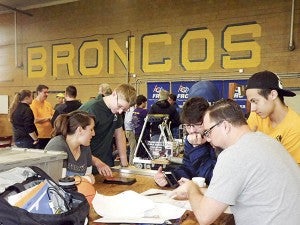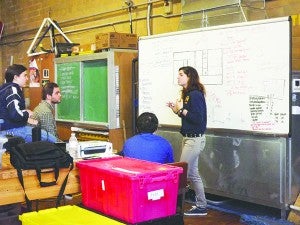B.O.T. 1610 on a quest
Published 11:02 am Wednesday, January 27, 2016

B.O.T. mentors Kyle Johnson and Cindy Mitrovic of Franklin review rules of the FIRST Robotics Competition in Virginia with teams from other schools in Hampton Roads. — Stephen Cowles | Tidewater News
FRANKLIN
The robot being designed by Builders of Tomorrow 1610 will not be taking over the world anytime soon. Instead, its human creators have a greater ambition: to conquer other teams.
Inside the Charles Street Gym earlier this month, members of Franklin High School’s B.O.T. 1610 again hosted visiting competitors for the annual review of rules, practice and strategy. This happened the day after the announcement for the international FIRST Robotics Competition of 2016 — FIRST Stronghold. The word is an acronym of For Inspiration and Recognition of Science and Technology.

In FIRST Stronghold, the teams have the quest to overcome opponents’ defenses and throw boulders (gray-colored balls) through the tower to earn points. — STEPHEN H. COWLES | The Tidewater news
In lieu of the actual robots, the students on a Sunday morning acted out the basics of the game, which involves overcoming an opponent’s defenses to throw boulders through a tower. A more detailed explanation is elsewhere on the page.
In between discussion and observation, different team members spoke about their experiences and expectations.
“Donald Wintersteen recruited me,” said Stephen Flournoy, 17, now in his second season. “I’ve wanted to do so for a long time. I’ve always like building things and being efficient in completing a task.”
The Franklin High junior foresees challenges, but isn’t daunted.
“I know this season is going to be tough,” he said. “Last year, we stacked totes. This year, there’s a different combination of obstacles. There are over 10,000-plus combinations.”

Members of Builders of Tomorrow 1610, the Franklin High School Robotics program, review plans during the practice session held earlier this month in the Charles Street Gym. Teams from other schools were invited as well. At right are mentor Shawn Geary and student Donald Wintersteen. — Stephen Cowles | Tidewater News
Wintersteen, 16, is on his third season, and credits his stepfather for encouraging him to try the competition.
“I really enjoyed it. Working with my hands feels natural,” he said.
Asked if there’s a significance to the number 1610, Wintersteen explained that meant B.O.T. was the 1,610th team to register for the program. Others in their company that day were NASA Knights 122; Menchville High School’s Triple Helix 2363; and Phoebus High School’s Phantom Mentalists 2028.
Devlin Moody, 14, is in his second year and credits Robotics advisor Liz Burgess for getting him involved, saying the group needed someone to help with programming.
“I really like how the games are played out,” Moody said. “That’s interesting.”
Josh Johnson, a sophomore at FHS, is going on his third year with the B.O.T.s.
“I’ve always been interested in robots,” he said, adding that his goal will be make this year’s creation work — the teams have to build a new robot every season.
As one of the strategists/semi-mentors, Cindy Mitrovic helps to figure out what path the robot will take during competition, as well as overseeing game play. Statistics and other data are compiled to create a plan.
Joining her that day was brother, George, an alumnus of the program, there to observe and offer support and insights that could useful.
Kyle Johnson returns as an enthusiastic mentor to the program. He explained that only one robot is used in the competition.

Cindy Mitrovic leads an early strategy planning session. Her brother George, an alumnus of the program, attended for support and advice. — Stephen H. Cowles | Tidewater News
“In the past, as funds have allowed, we have built a duplicate “practice” robot. Since we need to have spare parts for the robot anyway, and the team has been operating since 2005, we can typically throw together to make an identical or near-identical practice robot.
“However, when we go to competition, we are not allowed to bring the practice robot. We are allowed a 30-pound “withholding” of pre-fabricated parts. We can bring spare electronics and stock metal without counting to our “withholding” limit, but anything like an entire spare intake would count towards that weight.”
Other mentors include Hank Mummert, Don Shanks, Eliese DeGroff and Shawn Geary.
Though FHS science teacher DeGroff certainly knew of the robotics program before, this is her first year that she has become actively involved as a mentor.
“I got really interested in it,” she said about the program. “It amazes me.”
Geary, who is the reading specialist at S.P. Morton Elementary School, said Liz Burgess encouraged him to help. He started by watching recorded competitions and found himself getting as excited about them as if he were watching a football game.
Johnson said that as of Tuesday, there are four weeks left to finish building the team robot.
Robots no more grow on trees that money on your fathers, so B.O.T.s have cultivated a strong local backing to buy the materials. Featured sponsors are: Highground Services; FCPS; Franklin-Southampton Charities; Lowe’s; Burgess and Co.; ST Tissue; BAE Systems; and J.J. Technologies.
“We rely heavily on sponsorships from local businesses and charities, but some of those funds are “bookmarked” for specific things. We can use some funds for robot parts, but not for travel or food, etc.”
The team will first compete at the Southwest District Event from March 11-13 in Blacksburg, and the Hampton Roads District Event from March 18-20 in Churchland High School.
Additionally there is plenty of wiring, programming, and testing that needs to be completed.
Robots no more grow on trees that money on your fathers, so B.O.T.s have cultivated a strong local backing to buy the materials. Featured sponsors are: Highground Services; FCPS; Franklin-Southampton Charities; Lowe’s; Burgess and Co.; ST Tissue; BAE Systems; and J.J. Technologies.
A student interested in participating on a team does not have to pay an entry fee, but Johnson added, “we ask students to purchase their team shirts, offset some of the cost of hotel rooms, and to pay for their own meals when we travel.
“We rely heavily on sponsorships from local businesses and charities, but some of those funds are “bookmarked” for specific things. We can use some funds for robot parts, but not for travel or food, etc.”
The team will compete at the Southwest District Event from March 11-13 in Blacksburg, and the Hampton Roads District Event from March 18-20 in Churchland High School.
The Tidewater News will be following the local team during its season, meanwhile, you can also learn more at www.virginiafirst.org.
It matters how you play the game
This year’s game is as follows:
Each alliance has a quest. The robots move on their own for the first 15 seconds with points scored through reaching and crossing opponents’ defenses and scoring boulders (gray-colored balls) through goals in the opposing tower.
The humans then operate the robots for 2 minutes 15 seconds to defend their own castle, retrieve boulders, defeat defenses, score goals from the opponents’ courtyard and capture and scale their tower.
Hmmmm. All this sounds a little like that game where people throw balls into netted hoops. Perhaps it’s just a coincidence.
Within the Outer Works, which is the outermost line of fortification, there are eight defensive options with over 18,000 possible field configurations. There’s one permanent (a low bar), with another chosen by the audience from time to time and three are picked by the alliance just before each game starts.
Once the quest begins, illuminated lights on each defense side are reduced to signal when an opposing robot fully crosses it for the first time, then go dark after a second incident to show the defense is damaged.
Once any four of the five defenses are damaged, the fortifications are considered breached and the charging alliance gets points.
As mentioned, there’s a tower, which has openings for the boulders. Every time a robot scores, lights are decreased to indicate the tower’s strength has been weakened. The tower flag drops when enough boulders are scored, and then the tower can be captured at quest’s end.
There’s a time for capture in the last 20 seconds of the game, with robots allowed to surround and scale the tower for capture. When that happens successfully, the flag is raised on the opposing tower and more points are earned.
Ultimately, the alliance with the highest score at the end wins the quest.





